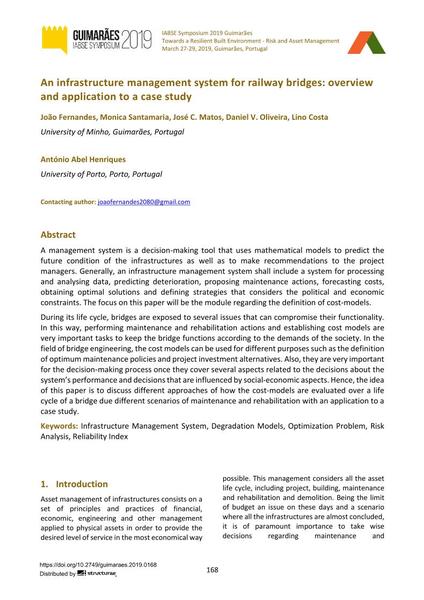An infrastructure management system for railway bridges: overview and application to a case study

|
|
|||||||||||
Détails bibliographiques
| Auteur(s): |
João Fernandes
(University of Minho, Guimarães, Portugal)
Monica Santamaria (University of Minho, Guimarães, Portugal) José C. Matos Daniel V. Oliveira (University of Minho, Guimarães, Portugal) Lino Costa (University of Minho, Guimarães, Portugal) António (University of Porto, Porto, Portugal) Abel Henriques (University of Porto, Porto, Portugal) |
||||
|---|---|---|---|---|---|
| Médium: | papier de conférence | ||||
| Langue(s): | anglais | ||||
| Conférence: | IABSE Symposium: Towards a Resilient Built Environment Risk and Asset Management, Guimarães, Portugal, 27-29 March 2019 | ||||
| Publié dans: | IABSE Symposium Guimarães 2019 | ||||
|
|||||
| Page(s): | 168-175 | ||||
| Nombre total de pages (du PDF): | 8 | ||||
| DOI: | 10.2749/guimaraes.2019.0168 | ||||
| Abstrait: |
A management system is a decision-making tool that uses mathematical models to predict the future condition of the infrastructures as well as to make recommendations to the project managers. Generally, an infrastructure management system shall include a system for processing and analysing data, predicting deterioration, proposing maintenance actions, forecasting costs, obtaining optimal solutions and defining strategies that considers the political and economic constraints. The focus on this paper will be the module regarding the definition of cost-models. During its life cycle, bridges are exposed to several issues that can compromise their functionality. In this way, performing maintenance and rehabilitation actions and establishing cost models are very important tasks to keep the bridge functions according to the demands of the society. In the field of bridge engineering, the cost models can be used for different purposes such as the definition of optimum maintenance policies and project investment alternatives. Also, they are very important for the decision-making process once they cover several aspects related to the decisions about the system’s performance and decisions that are influenced by social-economic aspects. Hence, the idea of this paper is to discuss different approaches of how the cost-models are evaluated over a life cycle of a bridge due different scenarios of maintenance and rehabilitation with an application to a case study. |
||||
